Winona Ryder’s Songs of Innocence and Experience
Winona Ryder is a brilliant and beautiful American woman of 52, small, warm, slightly dotty, and completely irresistible. To say that she is good company is to observe that the skyscrapers in New York, where we meet, have many floors. She is charming beyond, with a singular, freestyle approach to conversation, to life, that is by turns head-spinning, intense, and LOL funny — to herself, as much as to me or anyone else.
She has been famous since she was in her teens. She has lived a life of precarious highs and plunging lows. She is a star of a sort one seldom encounters, even in my strange job: a person engaged with the world, full of questions and thoughts about it, but also slightly distant from the everyday, a dancer to the beat of her own drum. If you are the sort of person, as I am, who venerates those people who go at things in their own way, who make their own rules, then this Winona is for you. If you ask me, she ought to be available over the counter. The world would be a better place.
(She’d doubtless roll her famous eyes at all this starstruck unctuousness, but that’s another attractive thing about her — for all her accomplishments, and her notoriety, her ego appears to be firmly under control.)
She’s also a survivor, of dizzying early success, of scandal, of sexism, of ageism, of her own mistakes and of the appalling behaviour of others. She has been fêted. Also traduced. All of which she will discuss, among very many other things, over the hours we talk for this piece.
At one point she mentions her interest in the visionary English poet William Blake, just one name among — this is not an exaggeration — the hundreds of references to writers, directors, photographers, actors, musicians and artists, with which she peppers her conversation. Do I know Songs of Innocence and Experience, she asks. It happens that I do, and now I also know that her own story is full of those songs. Songs of early promise and later disillusion and, later still, songs of overcoming, refusing to give up trying to do the thing she loves most — acting — even when it seems, as it has done more than once, that her moment has passed and the culture has moved on, and the achievements of her youth will never be repeated, still less surpassed.
Which makes our encounter sound very serious, and earnest, even pained. It felt like the opposite of that. Spending time in Winona’s presence, as I did over a couple of days this summer, a series of in-person conversations followed by perhaps the longest Zoom call of my life, is thrilling and inspiring.
She is a story-teller, an anecdotalist, but you have to listen closely, because her brain butterflies from one thought to the next, alighting on a topic briefly before fluttering to the next, making connections that aren’t always immediately apparent, following looping trains of thought that sometimes seem to vanish in the air — leaving both of us, I think, wondering where we are and how we got here and what we were talking about, but just as often landing decisively on a point, and making it firmly and clearly.
There is a cliché that says that famous people remain in some essential way the same age as they were when they first broke through, perhaps especially so in the case of child stars. They become fixed that way in the public consciousness (the doe-eyed teenager, the winsome ingénue, the grunge-era scenester) but also, this theory goes, their characters are, to borrow her own phrase on the subject, “frozen in time”. Winona became famous in 1988, at 16, with her third film, Tim Burton’s Beetlejuice, playing a disaffected adolescent, and there is something of the perennial teenager about her — intensely felt enthusiasms, wide-eyed curiosity, with a concomitant disbelief, disgust even, at the failures and compromises of the adult world. She is in touch with her inner teen in a way that other adults can’t quite manage, for all our strenuous and undignified efforts in that department.
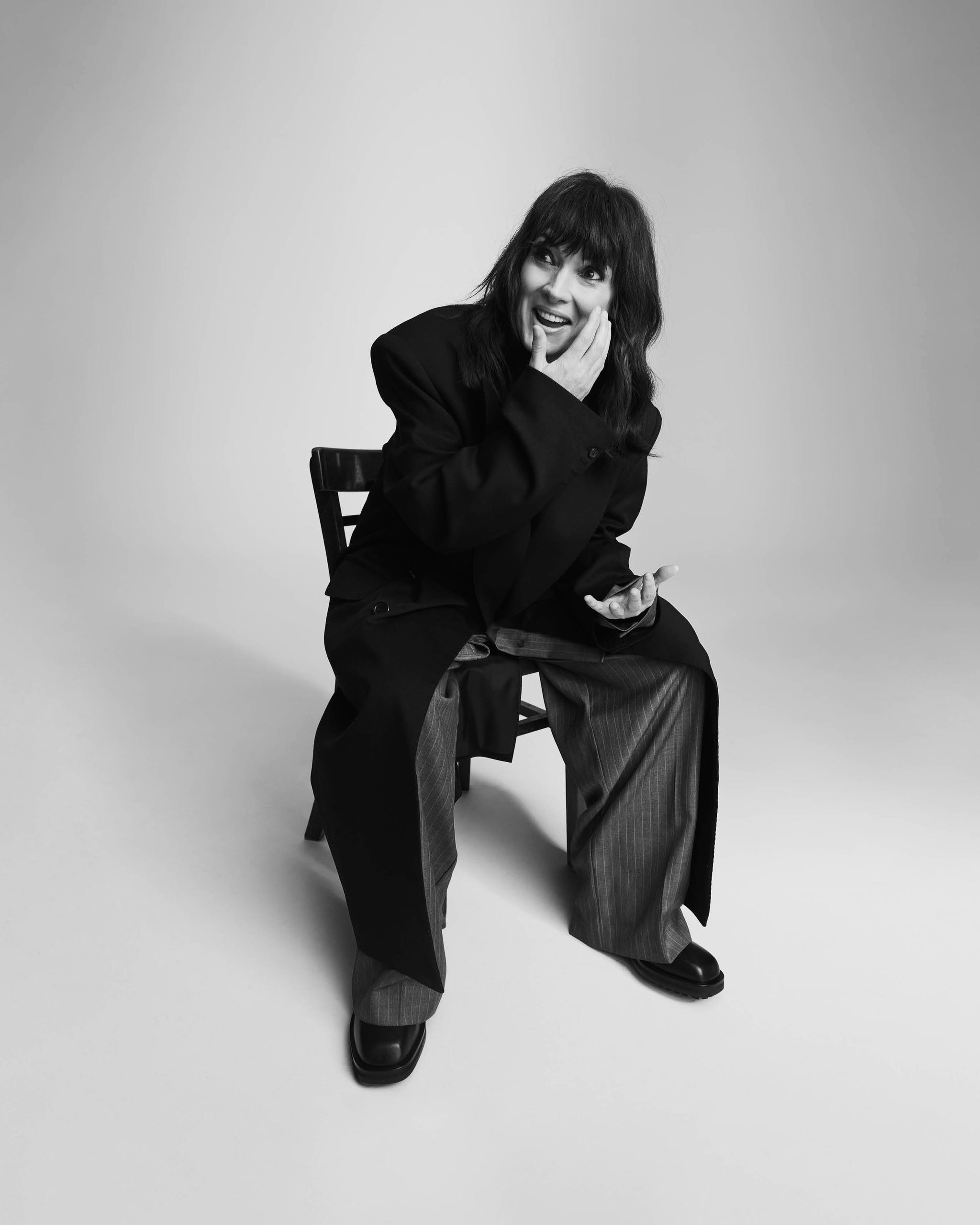 Simon Emmett
Simon Emmett
Coat, SAINT LAURENT BY ANTHONY VACCARELLO. Shirt and trousers, both THE FRANKIE SHOP. Boots, JIMMY CHOO
 Simon Emmett
Simon Emmett
“People often say that love young Winona Ryder. I had a great run, a hell of a run. It’s insane"
This youthful affect is combined with an apparently frictionless embrace of middle age. (It can’t really be frictionless, but it seems that way.) I am a year her junior, and it’s refreshing to meet a contemporary who isn’t trying to seem younger than they are, desperately signalling their deep engagement with contemporary pop culture, fashion, technology and attitudes. Winona is not on social media. She is, quite profoundly, not plugged in.
“I don’t live my life online,” she says. I wonder if she ever uses the internet. “I know how to use it,” she says. She Googles stuff? “I… I have.”
She’d rather you didn’t search for the year of that Gene Hackman movie she just mentioned, but instead try to work it out for yourself. (Scarecrow, 1973; I cheated.) And don’t quote her Elvis Costello lyrics because you’re reading them off a screen. Do it because you know them by heart, as she does. Or don’t bother.
She compares those of us who look things up on Wikipedia to those people who, pre-internet, read Cliffs Notes précis of books and repeated them verbatim, rather than engaging with the real thing and coming up with their own ideas about it. These are not her people.
When she tells me a story about a friend using an app to identify a song, the name of which had long escaped her, and I point out that Shazam is one of the fun uses of digital technology, she looks reluctant to agree even to this. (It turned out to be Syd Barrett’s “Gigolo Aunt”; she heard it at a Psychedelic Furs concert — of course she did.)
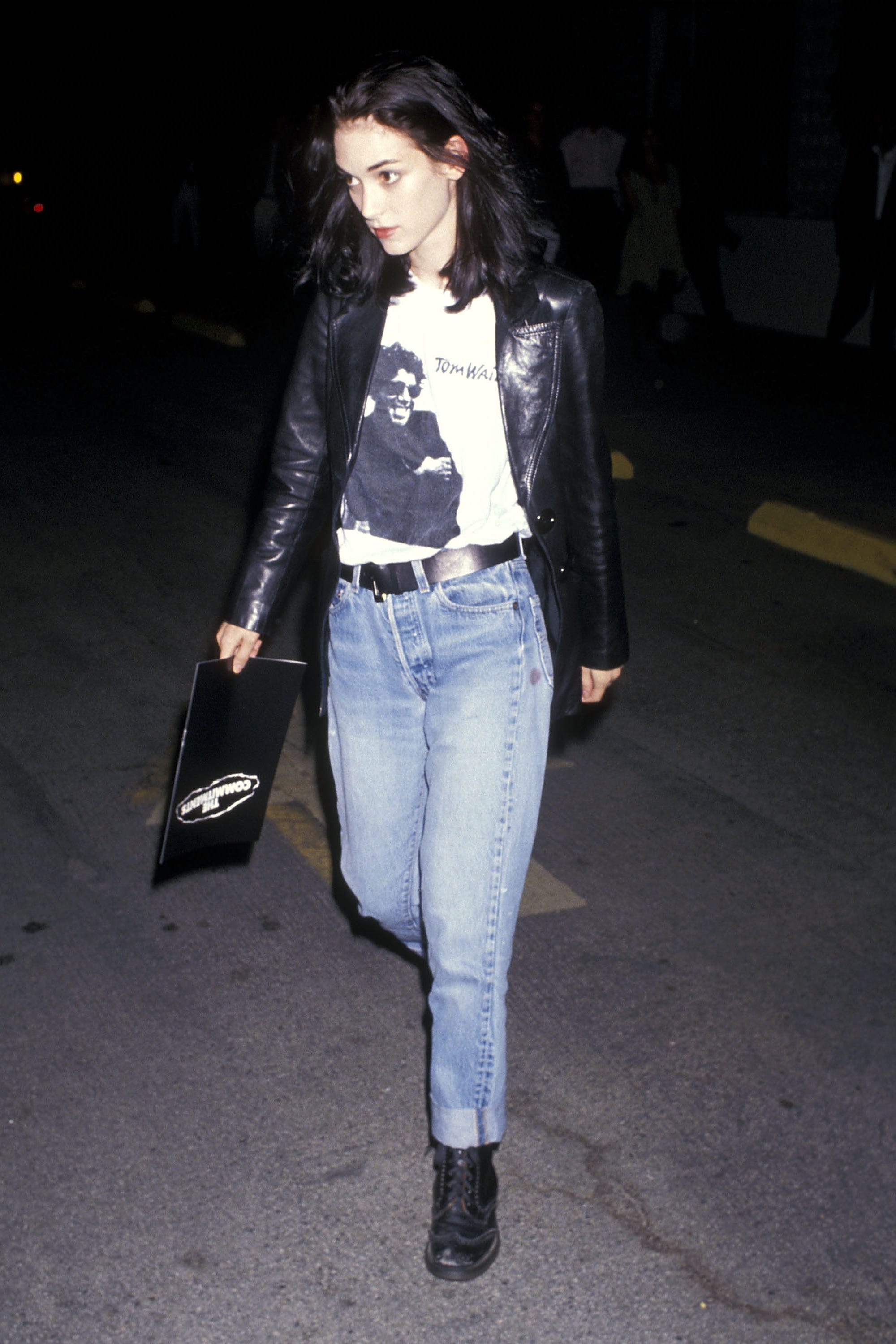 Ron Galella, Ltd.
Ron Galella, Ltd.
At a film premiere in Hollywood, 1991
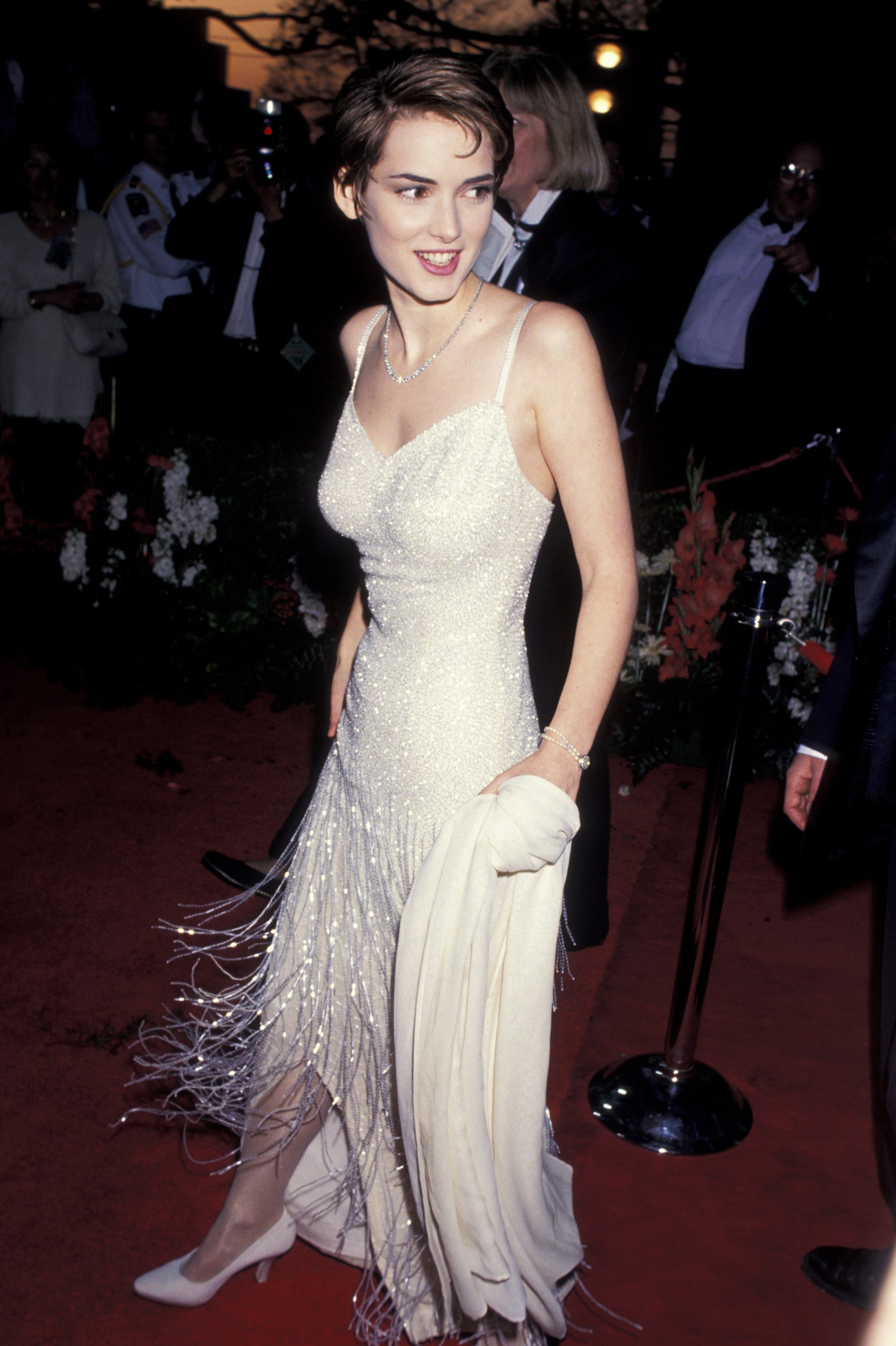 Ron Galella
Ron Galella
At the 66th Annual Academy Awards, 1994
Her knowledge of pop culture is encyclopedic, and she can talk for hours (actual hours) about obscure, though not to her, 1980s bands (The Dream Academy) and forgotten, though not by her, 1970s movies (Coming Home) and the work of actors (Marsha Mason) largely unremembered. Film, perhaps especially, she venerates. “It’s like it’s my religion.”
She is old-fashioned, then, and proud of it. A lover of physical things: books, records, clothes. She remembers an occasion on the set of the first season of Stranger Things, the hit Netflix show in which she takes top billing, in which she held up a vinyl record and the kids on the show didn’t know what it was. “I cried,” she says. The greatest sound in the world, she says, is that of the needle hitting the groove.
She regrets the fact that so many people now, even in her profession, are ignorant of the history of cinema. Even some directors, she says, have clearly only seen YouTube montages of classic movies. Young actors sometimes regard her badgering them to watch old films as condescending, even offensive, rather than generous, which is what she intends it to be.
“I just think that social media has changed everything, and I know I sound old. I’m very aware of that. And part of me thinks, ‘Gosh, am I like vaudeville at this point?’ Like [elderly lady voice], ‘Hey, kids, turn down the music!’
“But I just think there was such an abundance: the history of film, the history of photography, it’s so rich, and there’s so much there, and I don’t mean we should go backwards, but I wish and I hope that the younger generation will study that.”
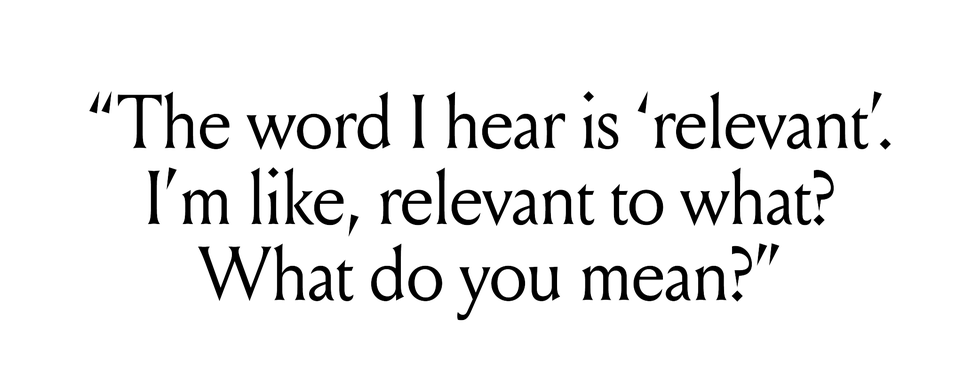
Esquire
Although she has no kids of her own, she talks a lot about teenagers, about how they are not listened to, their feelings diminished and overlooked. She worries about them, especially now, in our torturous online age.
“If you try to find out what they are into,” she continues, “it’s this idea of followers and how many you have. That’s all that matters, that you’re rich and famous.”
When she was their age, “any time I was going through a tough time, I was told that all that matters is that you’re OK. All this stuff [fame, money, popularity] doesn’t matter.”
“The word I hear is ‘relevant’,” says Winona, of a term used to dismiss those of us reluctant to surrender entirely to the digital life. “I’m always like, relevant to what? What do you mean? I’ve never quite understood.”
In a world that prizes youth, or at least the appearance of it, and in a business that all but insists on it, she is ageing appropriately. I didn’t ask her, because it seems like requesting someone’s medical records simply because you’re writing a piece about them, but her boyfriend told me that she has had no work done, no lifts or fillers or whatevers. She has one of the most expressive faces I have ever come across. It’s none of my business what she does with it, clearly, but it seems to me that it would be borderline criminal to freeze such a face — one that is in constant motion, shifting, within seconds, through multiple emotions: nervous, uncertain, vulnerable, reassured, amused, thrilled, enraptured.
Esquire’s art director Lauren Jones, who presided over our cover shoot, said Winona put her in mind of a high-school art teacher: appealingly unconventional in appearance; a woman with a twinkle in her eye that suggests an eventful past; a throwback to a more bohemian era: Winona is irreverent about authority but starry-eyed about rebels and outsiders; she approves of those who would stick it to the Man.
She’s not an art teacher, obviously. A friend who has met her socially says, simply, that Winona is an artist.
(I’m going to stick with first-name only, by the way, because do you know another Winona?)
She was, for a decade and more, a face of her (my, our) generation. Because I am weird and, like her, fetishise arcane objects, I am in possession of a copy of The Face[1] magazine from July 1994, with her photo on the cover, in black and white, topless, with CDs pressed to her chest to preserve her modesty: “Generation X,” shouts the cover line. “Who Is It? What Is It? Does It Really Exist?”
Fully 30 years later, in Dover Street Market, London’s most fashionable boutique, you can buy Winona baseball hats, and T-shirts with her face on them. Soho’s trendy Idea bookshop has sold out of The Winona Book, published last year. I order my copy from a seller in Northern Ireland: 140 pages of Polaroids of her, taken by her friend Robert Rich, a former PR for Marc Jacobs, a series of snapshots of turn-of-the-century downtown chic. (Her relationship with Marc Jacobs, the man and the brand, is long-standing.) She won’t allow the phrase herself — more eye-rolling — but if anyone can be said to be a style icon, it’s Winona. As is often the way, what makes her cool is that she’s not trying to be cool.
Unlike some other style icons, who are valued for their beauty, their poise, their taste, but not always their talent, Winona has amassed a significant body of work, to which she continues to add. She has appeared in cult classics, prestige costume dramas, art-house oddities and commercial studio films. She has worked with the most eminent directors, the finest actors and the biggest stars. For a time, in the mid-1990s, she was one of the most successful and admired actors in Hollywood, a Golden Globe winner, twice an Oscar nominee. Then she spent almost 15 years in the wilderness, working mostly under the mainstream radar. In 2016, Stranger Things[2] returned her to centre-stage. She is working on the fifth and final season now.
At the start of September, 36 years after the release of the original, she returns in a sequel: Beetlejuice Beetlejuice[3], alongside original co-stars Michael Keaton and Catherine O’Hara, as well as the 21-year-old actor Jenna Ortega. It’s directed, like the first film, by Tim Burton, and it’s one of the big releases of autumn.

That alone would supply a convenient justification for a nosy celebrity interviewer to delve into a subject’s past but, it turns out, none is required.
She arrives at a hotel restaurant in Williamsburg, Brooklyn, on a Sunday afternoon, in the middle of a thunderstorm.
She is late but disarms me immediately with profuse apologies. “Oh my God! I am so sorry! You’ve been waiting. I am so embarrassed!” And she launches into a story about why she’s been held up. It’s a good one. From her rented apartment nearby, she’s been attending a virtual memorial for Donald Sutherland, newly late himself. Not that she knew him. But she wanted to pay her respects to a magnificent actor, and to show her support for his son Kiefer, a former co-star. It was a Zoom call, which discombobulated her because that’s only the fourth time ever, she thinks, that she has been on a Zoom call. So anyway: sorry. And don’t mention it.
She is wearing an oversized black blazer with the cuffs rolled back, baggy black trousers that taper at the ankle, black lace-up shoes with a paint-splatter effect, and a black-and-red T-shirt. Her nail varnish is black. Her eyeliner is black. The only thing that isn’t black is her straw sun visor — on anyone else, comical; on her, quirky cool — which she stuffs into a large bag.
I find us a corner booth at the back. We slide in and study our menus. She says she’ll just have water and nothing to eat. I order a Coke. Actually, she’ll have a Coke, too, with lemon. And the chocolate cake. And vanilla ice cream. “Should I?” she says. “I might get too amped up.” Oh, what the hell. She eats the chocolate cake slowly, by which time the ice cream has mostly melted. She attacks it anyway, with a fork. This seems like the incorrect piece of cutlery to be used for transferring a liquid from bowl to mouth, but she perseveres, undaunted.
She fiddles around in her bag. She has a huge bottle of Fiji Water with her, which she sips from surreptitiously, as if it were contraband. She applies ChapStick, apologising for the fact that it’s tinted, although I can’t see why this is cause for apology. She has four separate pairs of glasses hooked onto the neck of her T-shirt. I don’t quite get to the bottom of what each of them is for — she only wears one pair briefly, for reading the menu — but she does say that she feels our eyesight is being affected by an over-reliance on screens and, pushing my own glasses up my nose (just the one pair), I’m not about to argue.
She is aware, I’m sure, that all this is slightly eccentric, and every time she does something kooky like that, and I can’t help laughing, she joins in, with a wry grin. I think the word for all this is charisma. It’s not full-beam superstar wattage, it’s gentler than that and, as a result, more insidious. It works its magic.
Typically, in the weeks leading up to an interview, I read as much as I can about my subject, speak to people who know them, study their work, make copious notes and then write a long list of questions, which I attempt to memorise. Sometimes I take the list out of my pocket to refer to, but mostly I try to wing it.
You want it to be a conversation, not an interrogation. But equally, you hope to shape the narrative a little, to direct the dialogue this way and that, and make sure you touch on all the important points. In Winona’s case, this careful preparation proves futile. Better to go with the flow, see where it takes us. Her stories are funny, surprising and sometimes disturbing.
After about two hours, her partner of 14 years, Scott Mackinlay Hahn, arrives to collect her. She’s not close to finished so he takes a seat, and the remaining 90 minutes or so of the interview is a companionable three-way conversation. Scott, a sustainable-fashion entrepreneur, is a ruggedly handsome man, bearded, with a plume of white-grey hair. He’s softly spoken, sincere and extremely well informed about the world. Our conversation touches on politics in the US and the UK, society, TV, the environment, mental health, ageing, technology — and also, happily for this article, Winona’s life and career.
I encourage her, as much as I can, to start at the beginning, because her story is extraordinary from the off.
She is the first-born child of Cynthia Palmer and Michael Horowitz, both writers, editors, archivists, activists and founders, in 1970, the year before Winona was born, of the Fitz Hugh Ludlow Memorial Library in San Francisco, which was the only library in the world exclusively devoted to the literature of psychoactive drugs, as well as the paraphernalia of drug-taking. It was, Winona tells me, with a delighted cackle, named for the writer of perhaps the first book on that subject, The Hasheesh Eater (1857). (Winona does a lot of delighted cackling, which is in itself quite delightful.)
She has a younger brother, Uri, and two older half-siblings, Jubal and Sunyata (it was the 1960s; her mother was a Buddhist), from Cynthia’s first marriage. She is named after the county of Winona, Minnesota, her mother’s home state, where she was born but not raised: she grew up in North Beach, San Francisco, until her family moved to a commune in northern California when she was seven. The commune was called Rainbow. It was near a town called Elk. They lived for three years on a remote, 380-acre plot, with seven other families and no electricity. The first films Winona saw were projected onto a sheet her mother had hung on the side of a barn. She remembers Leslie Caron musicals, Gregory Peck in To Kill a Mockingbird and many more.
Ryder is a stage name, borrowed from the singer Mitch Ryder, a favourite of her father’s. Her real name is Winona Laura Horowitz. Her father is Jewish, originally from Brooklyn, and she identifies as such. Her mother’s maiden name, Istas, means “snow” in Cheyenne (sorry, Winona, I Googled it), and since her twenties she has been involved in philanthropic work for the American Indian College Fund, which pays low-income Native Americans’ university fees. She is the product of multiple cultures, traditions and philosophies.
The Laura comes from a family friend, Laura Huxley, late widow of the English writer Aldous Huxley, author of, among other things, the psychonaut bible The Doors of Perception. Other Palmer-Horowitz close family friends and associates included the Beat poets Allen Ginsberg and Lawrence Ferlinghetti, who was Winona’s childhood baby-sitter, taking care of her in his office above San Francisco’s famous Beat bookshop City Lights. Also Dr Timothy Leary, maverick psychologist, LSD pioneer and, according to Richard Nixon, the “most dangerous man in America”. He was also Winona’s godfather.
“I grew up in a very liberal environment,” Winona tells me, deadpan.
She is and always has been close to her parents, who sound about as groovy and inspiring — and plain nice — as anyone’s parents could possibly be. They are still around, in their eighties now “and still together”, she notes, admiringly. They live in Canada, having quit the US in dismay at the political situation when George W Bush was re-elected, 20 years ago — a time, as Winona acknowledges, that now seems, by comparison, almost Arcadian.
(She doesn’t quite promise to quit the country herself if Trump wins a second term, but she says she has been “in a weird place” of thinking about it. Discussions with Scott about which coast they should settle on when she finishes Stranger Things — they currently divide their time between Brooklyn, LA and Atlanta, where the show is made — have, she says, “slowed down” while they await, along with the rest of the world, the result of the election in November.)
“Genuinely,” she says, picking up the thread, “[my parents] are my favourite people. They were so admirable in the sense of what they chose to do, as opposed to what they could have done. They were very educated, they could have taken jobs and settled down, but they followed their hearts. They did what they loved. Writing together. Running the museum. Activism.” Her dad was involved in the Civil Rights movement. Her mother worked as a volunteer hospice nurse in San Francisco during the Aids crisis. “I really revere them.”
Also, “they are archivists, and I definitely inherited that gene.” She’s a hoarder. In the following days she texts me photos of pop-culture ephemera she has collected over the years: movie posters, tour T-shirts.
She is like Cindy and Michael in other ways: “Just the little things like having multiple pairs of glasses and then going, ‘Where are my glasses?!’ all the time.”
Some people raised by free spirits in a permissive atmosphere rebel by becoming conventional, even prim. “Round people have square babies, right?” she says. In her case, not.
“That’s true, although I did rebel a bit. I was quite…” Square? “More conservative. You want what you don’t have, and I’m sitting on this incredible 380 acres with redwoods, and wishing I could live in a suburban neighbourhood.”
When she was 10, the family moved to Petaluma, California, where she attended public school. It was a case of careful what you wish for. “I had a hard time. I was very bullied.”
At her mother’s suggestion she took her first acting classes at the American Conservatory Theater in San Francisco. There was no plan for fame and fortune. “If you’d told me as a kid that I would end up in movies… I never, ever thought that that was going to happen.” Nevertheless, she began to audition. “I just wanted to get out of Petaluma.”
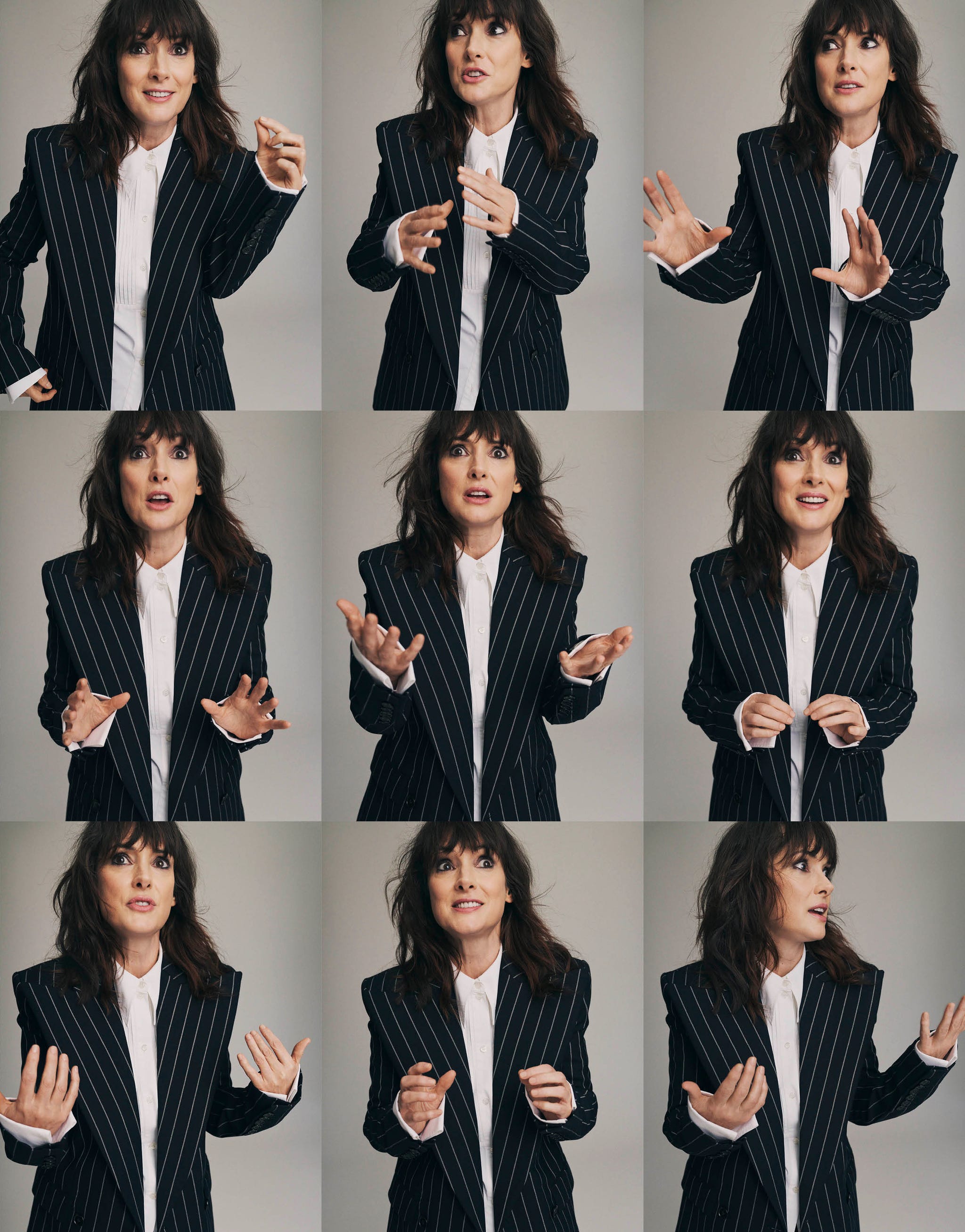
Simon Emmett
At 13 she won her first film part, in Lucas, a high-school drama, with Corey Haim and Charlie Sheen, both on a fast-track to infamy. Sheen, you doubtless know all about. Haim, who died in 2010 of pneumonia, aged 38, led a tragic life, defined by multiple addictions.
It was her first exposure, albeit second-hand, to the darker side of Hollywood. Haim was, Ryder remembers, already drinking heavily in his early teens. “I mean, he was a mess at 12, 13. I was just the awkward girl playing the awkward girl. I didn’t know what was going on in his home life, but it wasn’t good. It’s so sad. The industry can be very cruel.”
Her own parents had rules about what she could and couldn’t do. No missing school: all her movies were shot in the summer holidays. (She won a small part playing Robert De Niro’s daughter in Midnight Run, which she was obliged to turn down on that basis.) She had to keep her grades up to a high standard. And unlike many other families of child actors, Winona’s would not relocate to LA.
“That was the best parenting,” she says. “First of all, I have two brothers and a sister. And it’s just not fair. Entire families go to LA, there’s a lot of resentment, and then one kid ends up supporting the whole family. And I have a lot of friends who didn’t make it, who passed.”
At her screen test for Lucas, she met River Phoenix for the first time. He was fresh from Stand by Me, a sensation in the making. Over the coming years Phoenix and Winona were frequently paired in screen tests and, in 1993, they were preparing to make a film together — Broken Dream, to be directed by John Boorman — when Phoenix died of an overdose, aged 23, on the street outside an LA nightclub owned by Winona’s ex, Johnny Depp. That, she thinks, was a “crazy accident”. But it had a tremendous effect on her and her contemporaries. “It didn’t seem real. It was such a guttural, horrible thing.”
For all her hippie-royalty origins and her ringside seat to the excesses of 1980s Hollywood, the adolescent Winona was not, she says, a tearaway. “In my teens I was almost like straight edge,” she says. “My parents were pretty strict. One of them always had to be with me as my guardian. They were terrified of Hollywood.”
At 16, she made a film called 1969, with Robert Downey Jr and Kiefer Sutherland. “I don’t think I’m spilling any secrets: they were obviously wasted. To me, they were hilarious. It wasn’t, like, dark. Or maybe it was to them, but to me it was fun.” They were five years older than her, and their “scoundrel behaviour” did not include her. “I was the little sister.”
“Back then,” she says, “it was like acid and weed. I mean, you heard about cocaine, but I was never offered it until way later. I sort of weirdly rebelled against all that. Honestly, I didn’t do anything until I was like 28. I was just not into partying at all. Also, in my mind, I couldn’t have worked high, or drunk. [The thought of it] made me very nervous.”
Instead of late nights with the Brat Pack, her reverence for previous generations of film-makers and actors gained her entrée to a rather less rock’n’roll social circle. On her second film, Square Dance, she worked with the veteran actor Jason Robards, with whom she became friends. “My mentor,” she calls him. She became part of a circle that orbited Roddy McDowall, the movie star, then in his sixties. “He would have these dinner parties and invite me. It was, like, Elizabeth Taylor, Karl Malden, Jessica Tandy, Sidney Poitier. It was insane.” She shows me a photo on her phone. There she is, snow-white face and pixie cut, surrounded by legends of the stage and screen. “You see how happy I am! That was my drugs. Getting to talk to them.”
Beetlejuice was her big break. One of the best examples of Tim Burton’s distinctive brand of homespun pop surrealism, the film is an anarchic black comedy about cute young marrieds (Alec Baldwin and Geena Davis) who die in a car crash and return as ghosts to their rural Connecticut fixer-upper. When the house is sold to pushily pretentious Manhattanites the Deetzes, the couple call on the services of repulsive “freelance bio-exorcist” Betelgeuse, played by a barnstorming Michael Keaton.
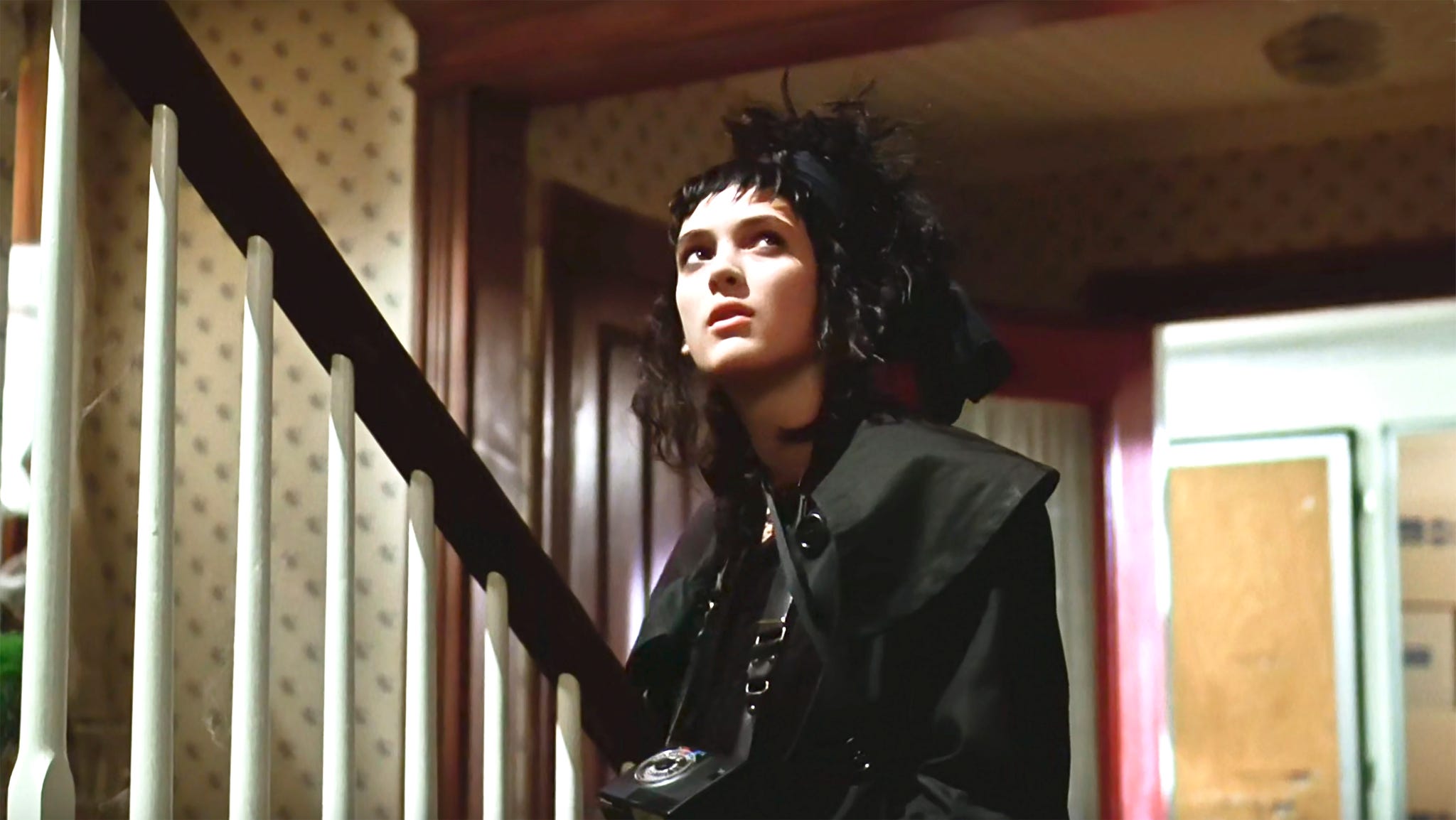 Supplied by LMK
Supplied by LMK
Winona Ryder in Beetlejuice (1988)
Winona, who was 15 during filming, 16 when the film was released in the spring of 1988, plays Lydia Deetz, daughter of the family. She makes her entrance being carried on a black couch, all in black, gloved and veiled. She looks like a hip crow. In this fable about the moral corruption of adult sophisticates, Lydia is the patron saint of moody teens. “My whole life is a darkroom,” she says. “A big, dark, room.”
There’s a formidable poise to Winona already, but also a sweetness. She is pure and well intentioned while the adults, unless they’re dead, are cynical, hypocritical, mean. It’s one of those roles so perfectly cast that it’s impossible to imagine another actor in the part.
“I was very much like Lydia,” she says. “They didn’t have to do much with me. My brother found a picture of me taken like a month before that audition. I’d dyed my hair blue-black, I had these crazy short bangs, and I dressed in black.”
From the first meeting with Burton — who was himself so young, at 28, to be the director of a Hollywood studio film that she initially mistook him for a junior crew member and engaged him in a discussion of the work of the creepy-story writer and illustrator Edward Gorey (Burton hired her on the spot) — right through the production and the release, she had a ball.
For the first time, she says, “I felt like I was me. I wasn’t trying to be something else. That’s a huge moment, for a teenager. It really helped define me.”
In some ways, it also spoiled her for other movies, “because Michael [Keaton] was so gentle with me. And Catherine [O’Hara, who plays her mother]. They always included me. They were so kind and so thoughtful. It was unique because as a kid actor you don’t always get that. It’s about the adults. It truly was the first time I ever felt like I collaborated on a movie. And I really had a connection with Tim. I remember going on to other movies and it was not like that. People weren’t so kind. It was much rougher.”
Beetlejuice was a hit. But its success didn’t do anything to stop the bullying at school. “I remember thinking that it was going to, like, change my status, and it made it worse. They were like, ‘You’re a witch! You’re a freak!’ It amplified it. I was like, ‘But I’m in a movie!’”
Her next film was another cult classic in the making, one that took aim at bullies from Petaluma to Poughkeepsie to points far and wide. From now on, high-school mean girls would be known as Heathers. In director Michael Lehmann’s delectable satire of that name — “the anti-teen-movie teen movie,” she calls it — Winona is Veronica, the cool girl with a conscience, led astray by Christian Slater’s sexy sociopath. “Dear Diary,” she narrates, “my teenage angst bullshit has a body count.”
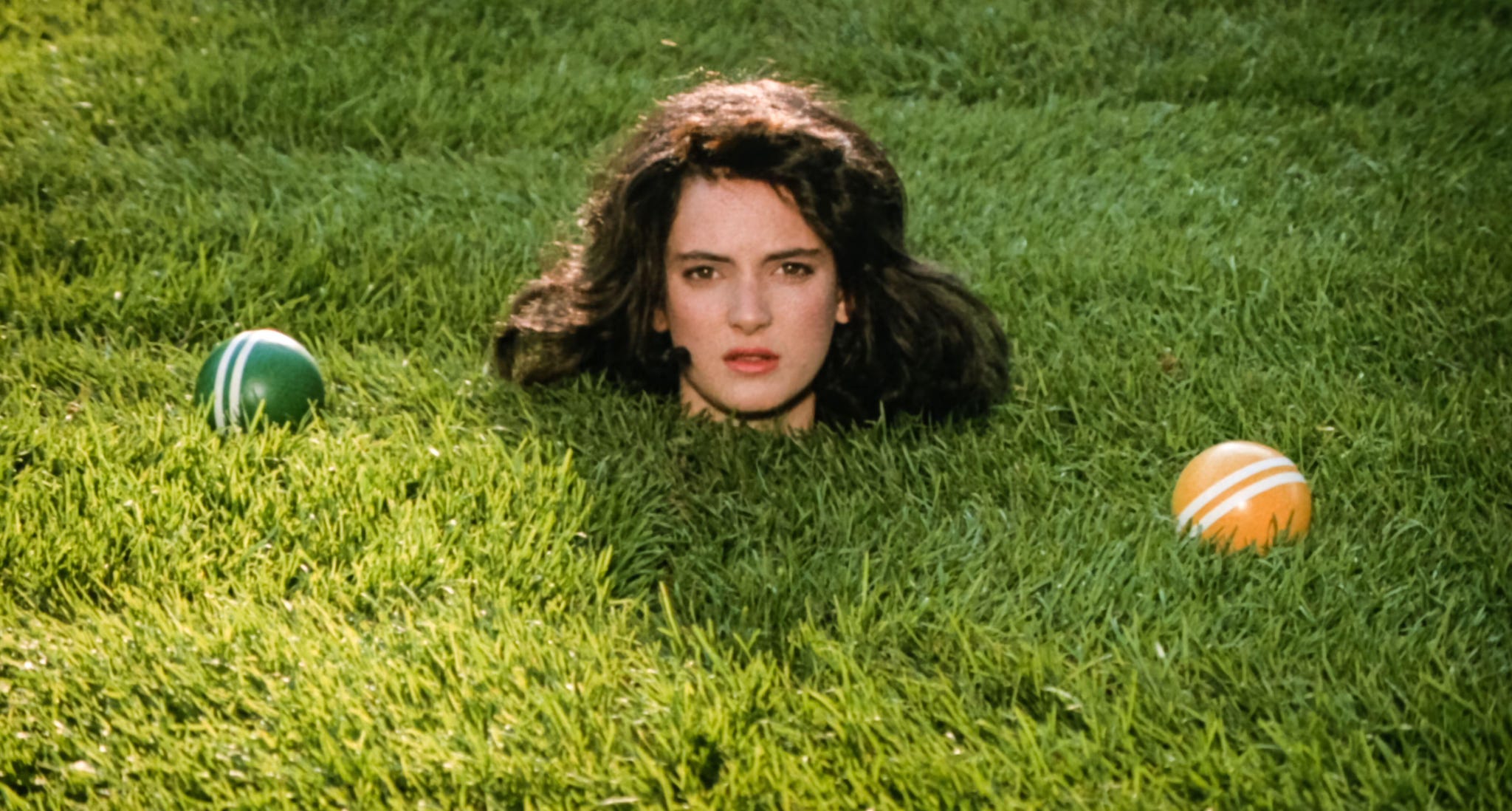 Alamy
"Nobody really came. I mean it was talked about, but it wasn’t seen”: Winona Ryder in Heathers[4] (1988)
Alamy
"Nobody really came. I mean it was talked about, but it wasn’t seen”: Winona Ryder in Heathers[4] (1988)
It’s a suicide comedy — they don’t make ’em like that any more — in which almost every line is quotable. “It’s so fucking great, right?” says Winona. “But it completely flopped.”
The marketing budget was so small that Winona and some of the cast and crew pitched in to pay for ads. She and Slater were sent on a tour of colleges to promote the film, “and nobody really came. I mean it was talked about, but it wasn’t seen”.
Still, The Washington Post crowned her “Hollywood’s most impressive ingénue.” She scoffs rather at some of the films that followed, including 1969 and Great Balls of Fire!, a biopic of Jerry Lee Lewis. “I was his 12-year-old cousin-bride.” More eye-rolls.
It was at the premiere for that film that she met Johnny Depp, her soon-to-be-fiancé and next co-star, in Edward Scissorhands, her second film with Tim Burton and the first in a run of hits that made her an A-list movie star at 20, at the same time as her relationship made her a tabloid fixture. As is the way with these things, the union of Winona and Johnny, Hollywood’s brightest and prettiest young things, did not simply add to their fame. It multiplied it.
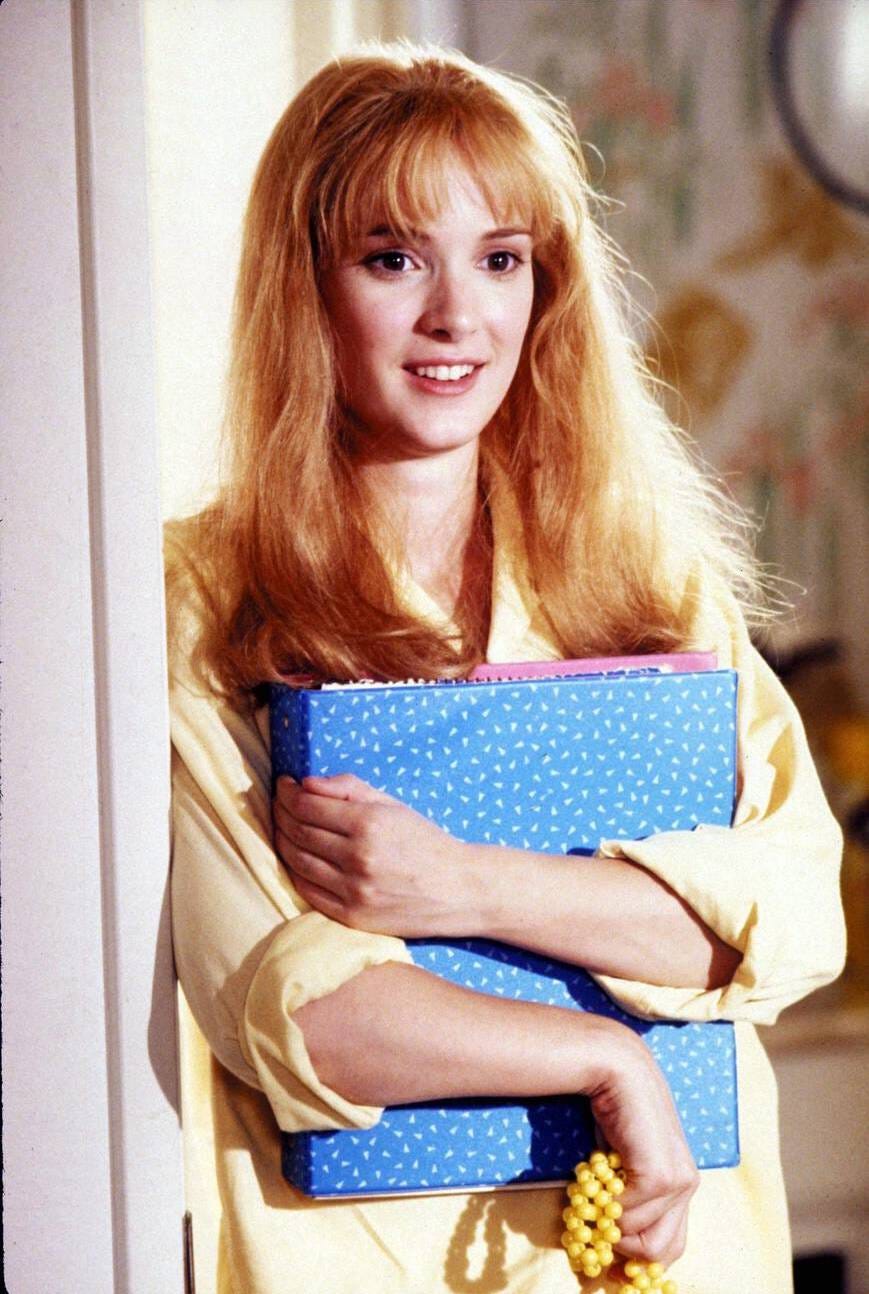 AJ Pics / Alamy Stock Photo
AJ Pics / Alamy Stock Photo
Winona Ryder in Edward Scissorhands (1990)
Edward Scissorhands is another of Burton’s twisted fairy tales, this one set in a spotless suburban fantasia, in which Depp’s leather-clad Edward, with blades for fingers, falls for Winona’s Kim, the blonde belle. “Hold me,” she pleads. “I can’t,” he whispers. Again, she was the moral centre of the film. She’s luminous in it, and very touching.
In 1990, she was Cher’s daughter in Mermaids and in 1991 in Night on Earth, a taxi driver for the indie auteur Jim Jarmusch. The year after that she was ravishing, and ravished, in Bram Stoker’s Dracula, for Francis Ford Coppola, with Gary Oldman[5] and Anthony Hopkins. The year after that she played opposite Meryl Streep, Glenn Close and Jeremy Irons in The House of the Spirits.
Better yet, also in 1993, she starred in Martin Scorsese’s sumptuous adaptation of Edith Wharton’s The Age of Innocence, a film she speaks of, still, with awe. “I was so fucking lucky getting to do that,” she says.
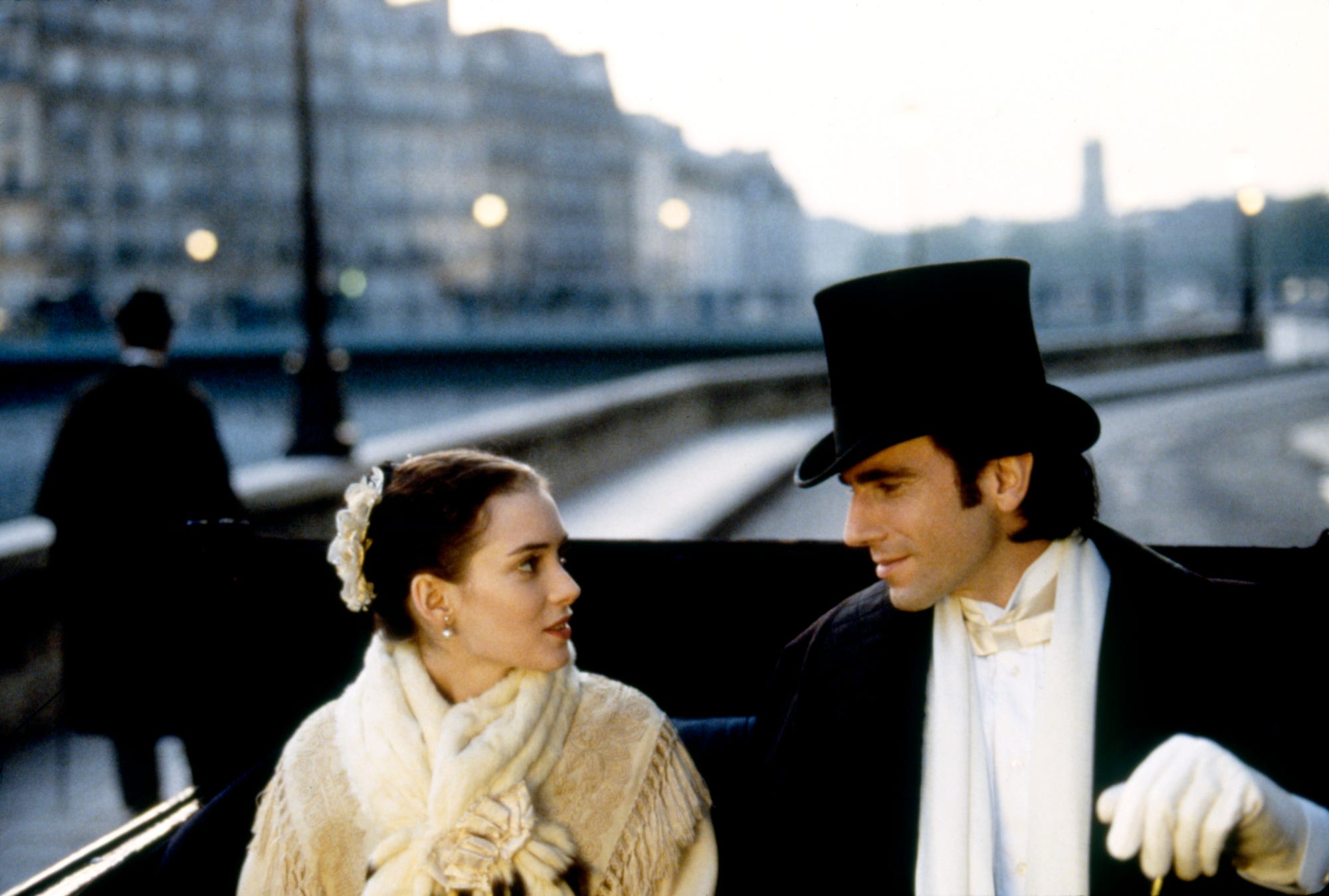 Columbia Pictures
Columbia Pictures
Winona Ryder and Daniel Day-Lewis in The Age of Innocence (1993)
She plays May Welland, strait-laced jewel of New York society, whose match with Daniel Day-Lewis’s rigid lawyer is threatened by the arrival of the exotic Countess Olenska, played by Michelle Pfeiffer. It’s a subtle and intelligent performance. May initially appears naive, even insipid, but she turns out to be made of steel.
“Age of Innocence felt like a graduation. It felt like everything I wanted to do. It was such a complicated role, and a huge turning point in my career. It’s also weird because you don’t want to peak at 21. Like, ‘How does it get better?’”
How does it get better?
“It doesn’t.”
Even so, as Jo March in director Gillian Armstrong’s Little Women, in 1994, she was nominated for Best Actress at the Oscars. That year she also starred in Reality Bites. A portrait of her over-educated, underemployed generation, Ben Stiller’s slacker dramedy opens at a university graduation with Winona, as Lelaina, class valedictorian, giving a speech that amounts to an epic shrug. Vulnerable, rudderless, hopeful, jaded, questing, self-absorbed: she wasn’t only the face of a generation, she seemed to embody its values and preoccupations. She was also cute, funny, stylish and smart.
“People often say they love Young Winona Ryder,” she says. And why wouldn’t they?
“I had a great run. It’s insane. If we count ’88 to ’98, that’s 10 years. That’s a fucking long run. That’s a hell of a run. Who has that kind of run?”
Does she, perhaps, love Young Winona Ryder, too?
“I do!”
You won’t be shocked to learn, as a reader of celebrity interviews, that fame does strange things to people, partly because it does strange things to everyone around them, everyone with whom they come into contact.
Winona didn’t go to college. “I think I probably still have a big thing about it,” she says.
She could have gone: she had good grades, and she made applications. But it was made clear to her that giving up film for three years when she was soon to hit her peak — she’d made Heathers, and was shortly to start on Edward Scissorhands — would not be advisable.
And then there was the fame. When she was 18 or 19, she went to Vermont for a weekend, to visit a friend who was studying at Bennington, the liberal arts college.
“I do remember being treated very differently because of who I was. It was this immediate, ‘Oh, you think you’re so special.’ I was like, ‘No, no! I’m just visiting a friend!’ I was actually quite shy. But I got that [reaction] immediately and I was like, man, I’m not sure I could handle this vibe on a daily basis.”
Even as a teen she had her first realisation of, “Oh, you wouldn’t be talking to me if I wasn’t who I was.”
That’s still the case, to an extent. “It’s interesting, when I meet someone, they’re always so surprised that they can find a common ground with me. And I’m really used to being underestimated, in the sense of what people assume actresses think about or are like.”
She found romantic relationships difficult, for a long time. She remembers an occasion in her late twenties, in a bar in San Francisco. She got talking to a guy, a gorgeous Irish kid called Colin, something of the Nick Cave about him. They were having a great conversation, about music and theatre.
“I went to the bathroom and when I came back he was talking to someone and I overheard him saying how he was going to, like, score with Winona Ryder, and I was so crushed. Not only because I thought that we had this genuine connection but also like, ‘Is this my life?’. Am I never going to get to meet someone and they’re going to know me based on our conversation [rather than her celebrity]?” She worries that telling this story makes her sound conceited: oh, poor Winona, all the cool guys want to sleep with her. “It’s not something I can easily talk about with other people, certainly not other people who haven’t experienced it.”
After she split with Johnny Depp in 1993, she had a handful of relationships with high-profile people, including a couple of rock stars and Matt Damon. But by the end of the 2000s, she was through with love.
“I was like, I’m fucking done. I was like, I’ll just be a spinster.” And then she met Scott. “I know for younger people it’s a hard thing to hear that it’ll happen when you least expect it. But…”
“We met at a really great time of life,” Scott tells me. It was 2010. She was 38. He was 39. They were at a party for Black Swan, the Darren Aronofsky film in which she made a killer cameo as an ageing ballerina.
“He thought I was Milla Jovovich,” she says.
“No, I didn’t, Noni,” he says.
“It’s a huge compliment!” she says.
He’s giving me a don’t-listen-to-her look.
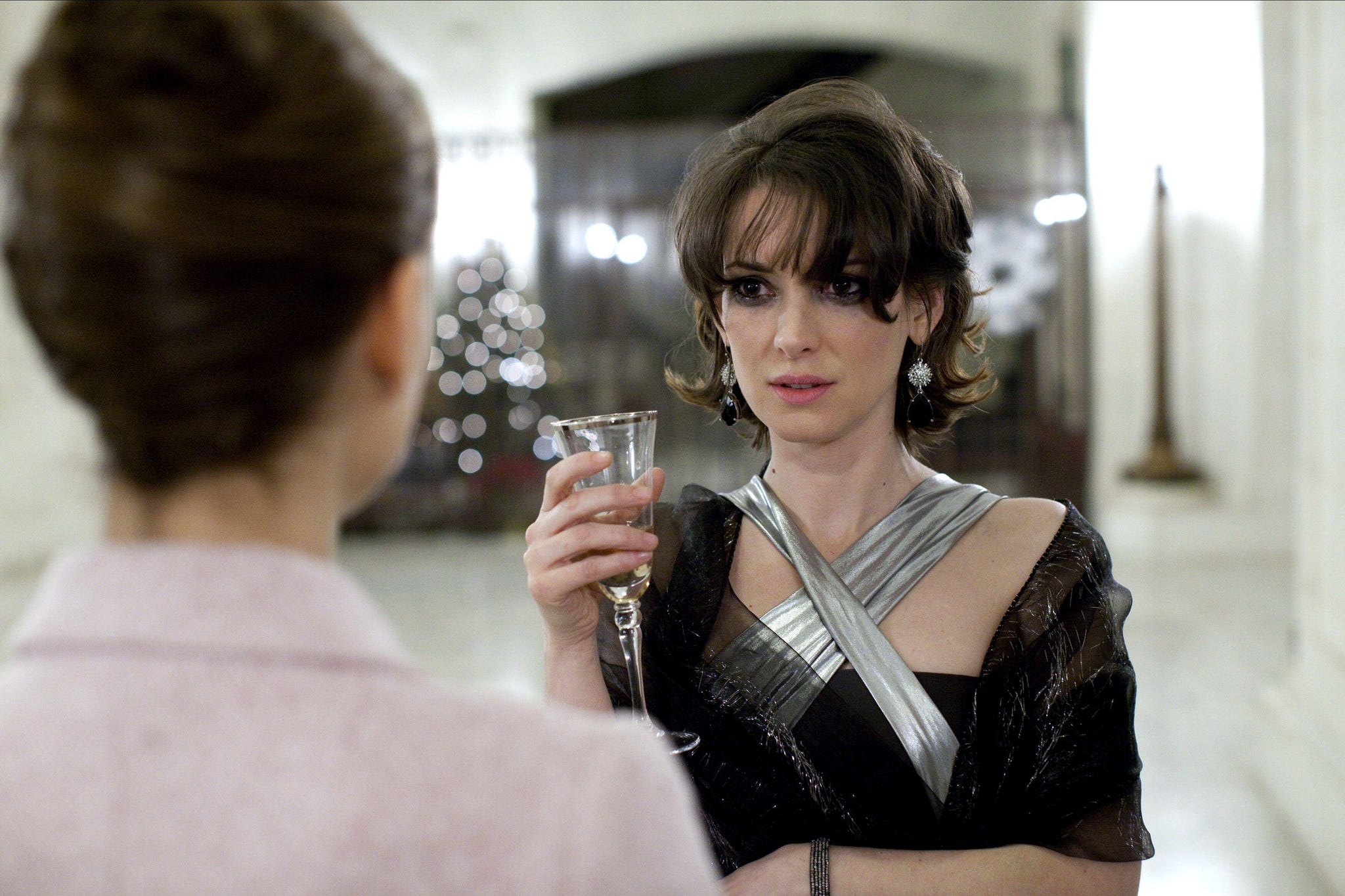 Alamy
Alamy
"He thought I was Milla Jovovich,”: Winona Ryder in Black Swan (2011)
She persists, claiming he had no idea who she was. He says that’s not true, it’s just that he didn’t have an encyclopedic knowledge of her career.
“Fate brought us together, through Darren,” he says.
“It’s been amazing,” she says, of their relationship.
I’m sitting between them, feeling the love, when I realise that maybe my research wasn’t quite as thorough as it could have been: are they married?
“Not officially,” Scott says, “but we’re about to be.” (Scoop!)
Congratulations! When?
“Probably later this year because it has to be even numbers.” He’s looking at Winona.
A superstition?
“You know how now everyone has ADHD?” Winona asks me. “When we grew up it was just called life, right?” That said, “I do have a preference for even numbers.”
The sky has darkened outside the restaurant as we talk. Her early career wasn’t all champagne and roses. As early as 1989, she pulled out of Francis Ford Coppola’s The Godfather Part III, exhausted, replaced at the last opportunity by the director’s daughter, Sofia. In 1999, in a TV interview, she reflected on a period in her early twenties when she checked herself into hospital for anxiety and depression.
Increasingly, for all her success, she found herself out of step with Hollywood. “Things were changing,” she remembers. “Studios were getting so much more powerful. Suddenly it wasn’t about working with Jim Jarmusch, it was all about numbers, how much things were making. It was like you were under this weird threat all the time, which felt like so much pressure. And all you ever heard was, if you take a break, you can’t come back. That was drilled into you.”
The kind of movies that she was pushed towards — mainstream blockbusters — were not the kind of movies she wanted to make.
“I was supposed to do this incredible movie with Miloš Forman that fell apart because it was a period piece and very cerebral. There was a great script that Christopher Hampton adapted of [Edith Wharton’s] The Custom of the Country. Michelle Pfeiffer had it first and then it got passed to me and nobody would make it because they considered it too expensive to make period pieces. That was a huge blow. I feel they started associating me with the kind of movies that they didn’t make any more.”
When she did find a script she liked, her celebrity was such that it, too, began to limit her opportunities.
“There was baggage,” she says. The obsessive interest in her love life. The hoopla that surrounded her. “Trying to convince someone to ignore the noise around me was tough. I saw it in their eyes. I lost a lot of parts because of that.”
She remembers a meeting with the director Michel Gondry, who was casting what would become Eternal Sunshine of the Spotless Mind, from a screenplay by Charlie Kaufman. “It was such a brilliant script and we were at this little restaurant and people kept coming up to me and there was a random paparazzi guy outside, which was kind of unusual for me, but I just remember [Gondry’s] face, and trying to convince him that this isn’t normal, and I know it’s not normal.” The part went to Kate Winslet.
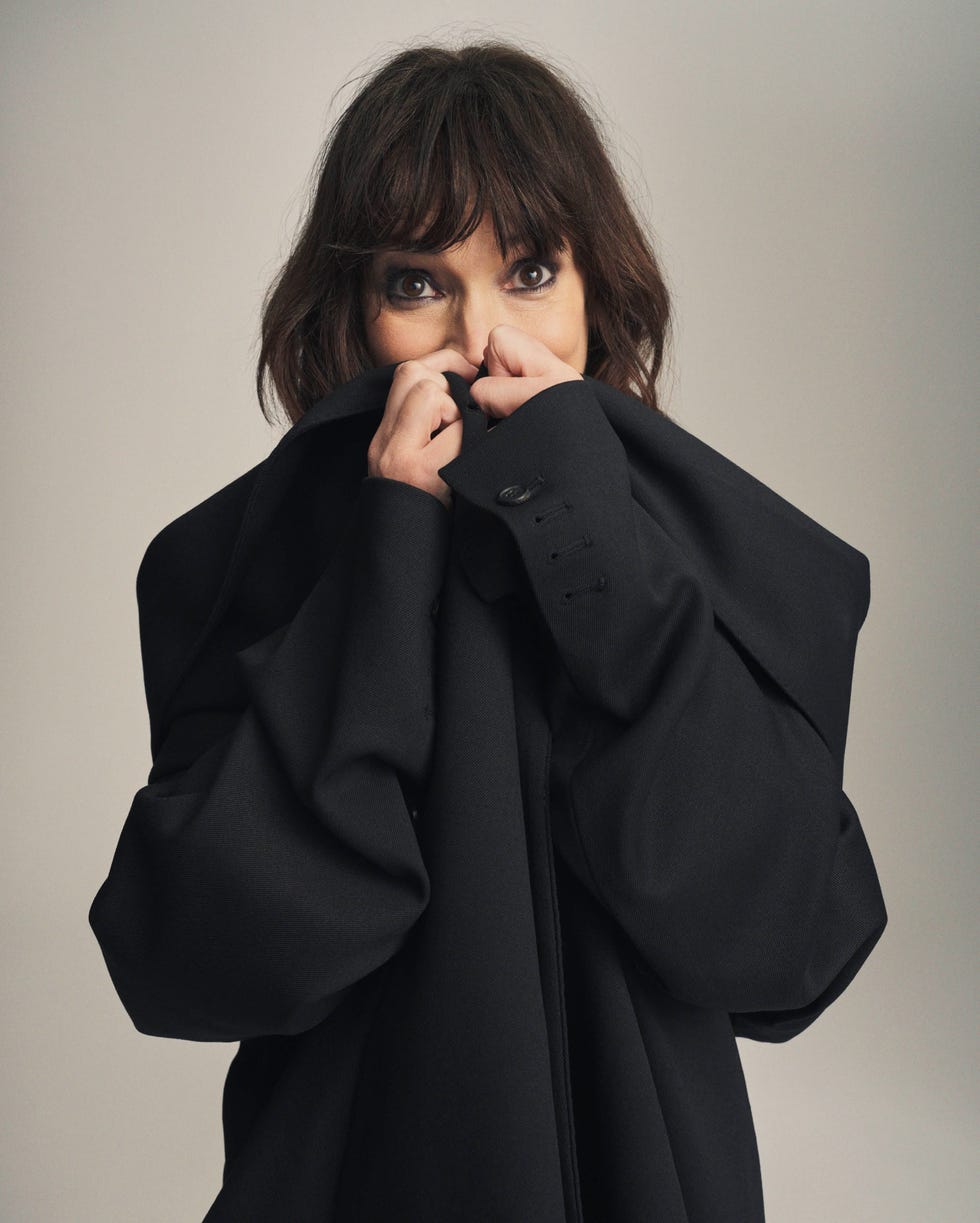 Simon Emmett
Simon Emmett
“If you’d told me as a kid that I would end up in movies... I never, ever thought that that was going to happen”
“I’m not in any way complaining,” she says. “But there was this whole time when I felt like I would be a distraction, as well. I got it. Certainly, in the 1990s, I became aware of that. And there was a switching-of-the-guard feeling, too. As you get older there are these new, younger actresses. It’s so drilled into you how disposable actresses can be, our shelf life. You hear it all the time.”
What she was offered, she didn’t necessarily want to do. These turned out to be career decisions. “Those big movies, you have an entire agency yelling at you to do it. I remember leaving agencies because they would scream at me [when she was reluctant to take a role in a big commercial film], ‘Are you fucking kidding? Who the fuck do you think you are?’”
One of those was a remake of the Audrey Hepburn classic Sabrina that the director Sydney Pollack was casting. “And I fucking love Sydney Pollack, of course! He’s brilliant. And of course I went on that meeting. But I was like, ‘It’s Audrey Hepburn!’” The idea of remaking a classic did not appeal. “I just remember getting yelled at [for not taking the part].” Julia Ormond played Sabrina in the 1995 version.
Not that there were no successes after her early 1990s run, but she had to fight for them. She buttonholed the director Nicholas Hytner at the Oscars, pleading with him to cast her in the 1996 adaptation of The Crucible. She was drunk, in a ball gown: “Joan Collins on a bad night.” It worked. The film reunited her with Daniel Day-Lewis, and she remains extremely proud of it. (Arthur Miller wrote the screenplay himself and was sometimes in her eyeline as she worked.) She co-produced Girl, Interrupted, a psychodrama about a young woman’s stay in a mental institution in the 1960s, an enduring favourite among young women particularly.
Other movies from this period were less successful: a misconceived Alien sequel; a May-September romance with Richard Gere; a lesser Woody Allen; an Adam Sandler vehicle. Her enthusiasm was dented.
“But also,” she says, “if you think about it, the late 1990s, early 2000s, who was on the rise?”
Who was on the rise?
“Harvey Weinstein.”
She says that during this time she was blacklisted by Miramax, the company Weinstein ran, with his brother Bob, until 2005. “I think it was various reasons,” she says. “The one time I was supposed to have a meeting with [Harvey Weinstein], I went to the Miramax office and I extended my hand and he shook my hand and I sat on the couch and we had a conversation and I left. And [afterwards] I got like screamed at [by an agent]. “What the fuck did you do?” I was like, “What?” Apparently, I offended him because I extended my hand?”
He was expecting something else?
“I guess.”
On another occasion, during production on The House of the Spirits, a Miramax movie made before that meeting, Weinstein pounded on the door of her trailer — she recalls all the details, down to the song playing on her stereo: “There She Goes,” by The La’s — and told her, in no uncertain terms, he wanted her to do a movie he was producing, the screen adaptation of the play Little Voice.
“And I was like, ‘Oh my God, I just saw that in London.’ I was like, ‘You have to cast that girl [from the play], Jane Horrocks. She’s fucking amazing.’ And he got very weird and he left.”
She thinks there were other reasons, besides those meetings, that he wouldn’t hire her, or prevented others from doing so. “I think I knew a little bit too much,” she says.
“He did not like me.”
She escaped falling victim to Weinstein’s worst outrages. But she did not escape the abuse suffered by actresses of that era.
“I had a couple of difficult experiences with a couple of people who were just blatantly sexually harassing me,” she says. This is when she was in her late twenties. “And then it happened again in my thirties. It wasn’t an assault. But it was incredibly inappropriate. It was wild. I really understand [what the victims of Weinstein and others went through]. I was lucky because I was known, so it didn’t happen as much as maybe it would if I had been a struggling actor. But I remember this feeling in your mind: you’re negotiating, you’re thinking about what’s going to happen if you say something. You’re working it out while this person is being extremely creepy.”
Recently, she was telling Jenna Ortega about these incidents. “And as I was saying it, I was like, ‘Jesus Christ, that’s really fucked up.’”
She had become accustomed, she says, to brushing off the unwanted attentions of men. “If someone was being inappropriate or drunkenly hitting on me it was like, ‘Ha ha!’. You kind of do that. ‘Ha ha!’ Inappropriate? I dealt with that. But touching me? It felt very invasive.”
She does not want to name any of those involved, or to go into what happened in detail. But she does believe that what she went through had a profound effect.
“I think in retrospect, it really soured [her on making movies]. All the great actors always told me that when it stops being amazing, you gotta get out. I really took that to heart.”
Turning her back on Hollywood, even temporarily, even at risk to her sanity, felt impossible. And then one day the decision was taken out of her hands.
There’s no way, I say to Winona, to tell her story without reference to the event that changed everything. It is, she concedes, “the elephant in the room, on steroids”. In December 2001, aged 30, she was arrested, and subsequently prosecuted and convicted, for stealing clothes worth $5,500 from a Beverly Hills department store. The CCTV footage played around the world.
She has spoken about this before and it seems unnecessary to make her relitigate the court case. I’m more interested in the reasons why it happened, and the effects it had on her life and career. “It definitely had a giant effect,” she says.
To me she suggests that what happened that day is not as clear-cut as it was made to appear.
“It’s so funny, because there’s so much lore around that story, but it really couldn’t have been more of me thinking I’m going to my car to get something…” She was, she says, in a daze. The whole world was, she feels, in the aftermath of 9/11. She hadn’t meant to steal anything. Initially, she didn’t realise what was happening. She felt she had made a simple error — accidentally walking out of the store without paying — and it could all be sorted out. “It kept being like, ‘Oh, it’s fine, this is just, like, paperwork,’ and I was like, ‘OK.’ I was so confused.”
Suddenly the severity of the situation became clear. “I just remember being told I was going to go to prison. I was like, ‘Huh? What are you talking about?’” More than anything, she tells me, she was embarrassed for her family.
She believes that her disenchantment with Hollywood was partly responsible for actions she can’t otherwise fully explain. She thinks that maybe, subconsciously, she needed something to happen to make the decision to step away from acting for her.
There had been more recent difficulties: she had broken her arm and been prescribed multiple painkillers, which explains her disorientation. She was struggling with her mental health. A close friendship had recently broken down.
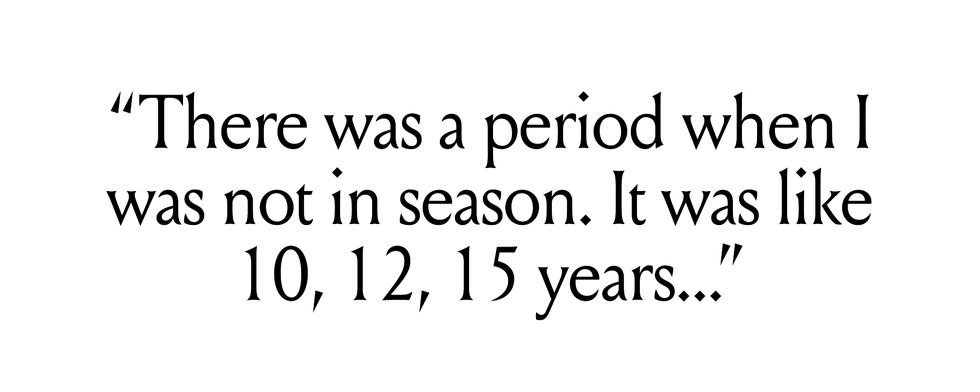
Esquire
The day after her arrest, news broke that Osama bin Laden had been tracked down to the caves of Afghanistan. The world’s most wanted man was no match for Winona: in the tabloids at least, she led the news agenda.
“So fucking surreal,” she says.
How did she cope with it all? “I checked out,” she says. “I think I just checked out.”
She was sentenced to three years’ probation, fined, and ordered to undertake community service. She left LA for San Francisco. She barely acted for five years. When she did return, it was to a new position in a radically altered entertainment industry.
“There was a period when I was not in season,” she says. It wasn’t a brief period. “It was like 10, 12, 15 years, and it did coincide with everything that happened [in her life] but also, if you look at the period from 2000 to 2010: wow! It was the most degrading time to be a woman. Even the cool people were participating in what felt like it should be off-limits.”
The internet had transformed the coverage of the private lives of celebrities. Famous young women, in particular, became prey to a new, more aggressive online media. The tone was punitive.
“I remember being really scared during that time,” she says. “It felt like there was a shift in the industry and the culture about what became acceptable and what became rewarded.”
She talks about the boorish gross-out comedies that defined that period, and the lionising of the men who starred in them.
“Actresses were being punished for not getting the joke, or not playing along. Everyone was trying to be the cool girl, sexualised but also one of the guys… I thought it was demeaning. I just remember feeling like, ‘Man, if this is the future, we’re fucked.’”
She worked with Richard Linklater on A Scanner Darkly. She was Spock’s mother in the 2009 Star Trek reboot. She had the cameo in Black Swan, her favourite film from this time. She played the founder of Al-Anon in a TV movie.
But it was harder than ever to find good material, and to get cast. In 2014 David Simon, creator of The Wire, was preparing a new show, Show Me a Hero — dirty politics in 1980s New York — and wanted her for a supporting role. “I know there were questions about whether or not I could do that,” she says. “Not from David but from the director: ‘Can she fit into this world?’ They didn’t think I could be this councilwoman from the 1980s. A lot of those conversations happen right in front of you. I heard them talking about my eyes, my Beetlejuice eyes.” She cut her eyelashes to try to persuade them. Some of the show’s makers worried that she would “pull focus” — her fame would be distracting for viewers. Simon prevailed, and was proved right. She’s excellent in it.
In the HBO adaptation of Philip Roth’s chilling, prescient The Plot Against America, a counterfactual history of the 1940s — David Simon again — Winona was terrific as a brittle Jewish woman so compromised by a romantic entanglement that she ends up dancing with Hitler’s foreign minister at the White House. It was not as much seen as it ought to have been.
She was working her way back. But it’s hard being a female actor in middle age. She talks about the limitations of the idea of the so-called “strong female lead”. Yes, women want to play the lead. But the character doesn’t have to be cartoonishly strong, like a male action hero.
“We want to play complicated characters,” she says. “Nuanced. We don’t necessarily want to play strong. We want something to work with!”
Instead, “You’re the kid, then you’re the ingénue, then you’re the DA, then you’re the judge. It’s like, [gravelly voice] “Chambers, now!”
From there, with magpie leaps, she bounces the conversation to Columbo, Wim Wenders, Little Britain, “fucking AI”, George Orwell, Northern Ireland and the climate crisis.
I wonder if she indulges, like the rest of us, in doomy prognostications about the future of mankind. She offers a prediction: “I give us four to six years before the planet fucking explodes.”
Before we call it a night, she asks the most unexpected question put to me by a famous person in almost three decades of interviewing them.
“It’s the worst game,” Winona says, “but who do you least want to be killed by: the Irish mob? The Italian mob? The Russian mob? Which would be the worst?”
On the spot, I settle on the Russians as my least preferred murderers. What about her?
An agonised squirm. “It’s so hard! They’re all so fucking brutal and they all do such things…”
At this point the unfailingly polite Scott is looking understandably restive, and I’m shattered. I tell them I’ll see them in the morning, at the photo shoot.
“Wait,” Winona says, “what day is tomorrow?” Monday, I tell her. “Today is Sunday?” She looks momentarily incredulous.
“I’m sorry we ended on such a violent note!” she says, as I ask for the bill. (Two Cokes, chocolate cake, ice cream: cheap date.)
“The Russians!” she cries. “The Italians! The Irish! Jesus!”
In my Uber back to the hotel I can’t wipe the grin off my face. What a lovely and unusual person she is. What a force!
Before I collapse into bed, I check my messages. Only one. A sweet and generous text from her, which ends with two black heart emojis. Oh, Winona! You’re the best.
The next morning — Monday — Winona and Scott turn up to the photo studio, also in Brooklyn, where she will pose for the pictures on these pages. While Simon Emmett takes the photos, and the assembled crew watches on, Winona talks to me about our shared passions — books (she’s a Philip Roth nut), music (Nick Cave, The Clash, Leonard Cohen, and on and on) and movies (Al Pacino movies, Faye Dunaway movies, Jane Fonda movies, movies, movies, movies). Together, we sing a bit of Fairground Attraction’s “Perfect”. Because why not?
I ask her if it can possibly be true, as I’ve read, that she attended the last ever Sex Pistols gig, at Winterland in San Francisco in 1978, with her dad. The one where Johnny Rotten sneered, “Ever get the feeling you’ve been cheated?” She thinks so. She would have been seven!
She tells me that when she met Joe Strummer once he gave her a cigarette, and she kept it. When he died, she buried it — her own ceremony of remembrance. She also extemporises on Israel-Palestine, the culture wars, the time she went to Blackpool with Tim Burton to shoot a video for The Killers, the photography of Danny Lyon…
She keeps talking while the lights flash, while her make-up is touched up, her hair is zhuzhed, and her clothes are pulled and adjusted. What about the David Gilmour/Roger Waters feud? Will it ever end? And have I seen the bit of footage when Robbie Robertson and Martin Scorsese first hear Van Morrison’s “Into the Mystic” and have their minds blown? It’s on The Last Waltz DVD extras. And The Panic in Needle Park! What a movie. And then she’s on to Musk, Elon, the creepiness of; Blair, Tony, the compromising of; Foster, Jodie, the amazing-ness of; Brand, Russell, the revoltingness of; Lancashire, Sarah, the magnificence of.
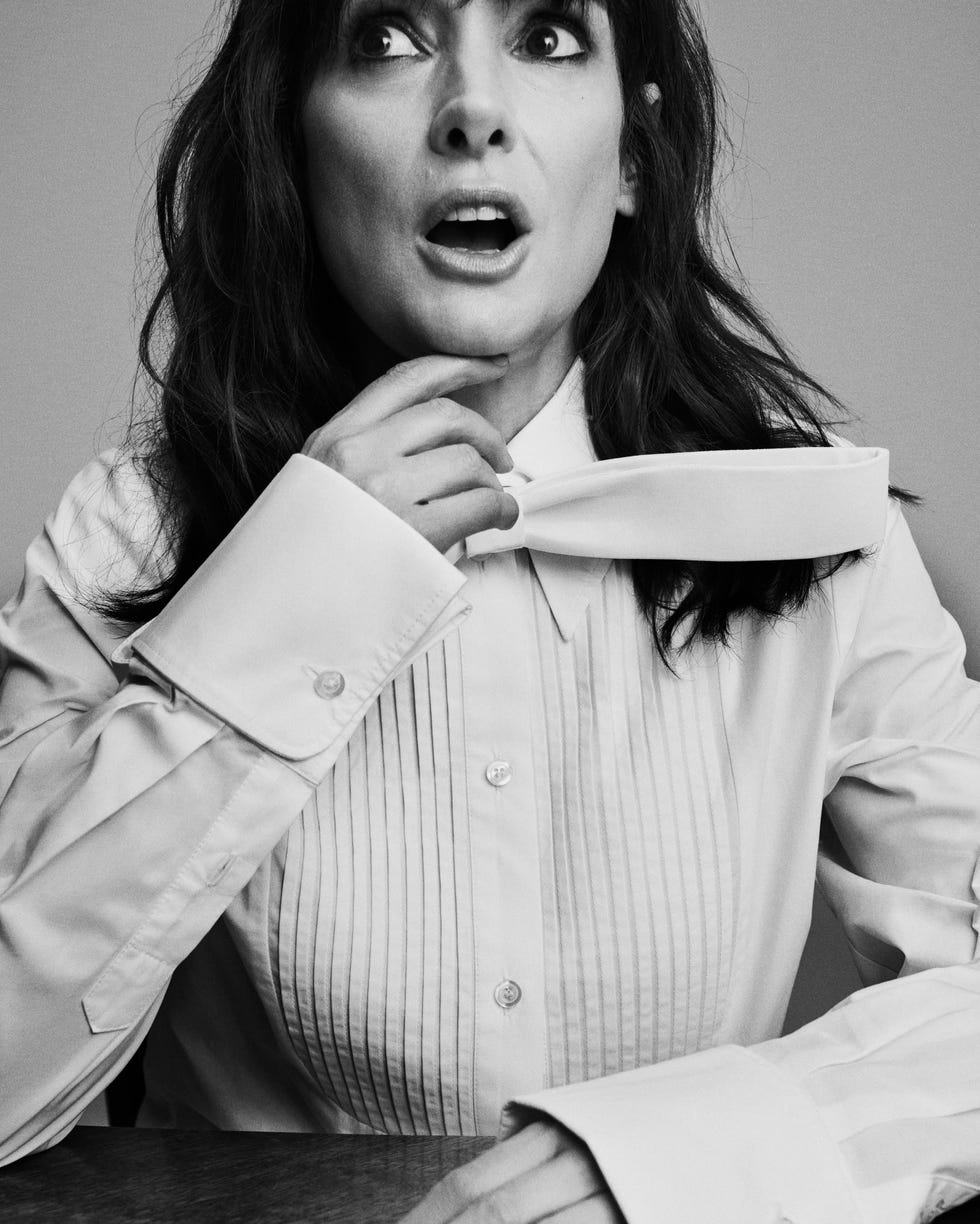
Simon Emmett
She says she wants to talk again, and so an arrangement is made for a Zoom call a few days later when I’m back in London.
And on a Friday evening in July she appears on my laptop screen, grinning. She’s wearing a black trucker hat with a picture of Leonard Cohen on it, black T-shirt under black dungarees, black, thick-rimmed spectacles. This time, I have my questions spread out on the kitchen table, my pencil in hand to jot down important points. I’m going to try to stick to some kind of script. Honestly, who am I kidding?
She starts with Keats, John, the life and loves of, and we go from there, talking for four hours. Much of the time she looks slightly off to the side, but when she’s really engaged she fixes me with those huge brown eyes and, while it’s impossible to achieve genuine IRL intimacy on a video call, the spell is summoned.
We talk about Stranger Things. Set in small-town Indiana in the 1980s, it’s a supernatural coming-of-age drama inspired by the genre movies of that decade, from Spielbergian sci-fi to John Carpenter-style creature features, high-school dramas, B-movies… a nostalgia fest for Generation Atari types such as me and Winona, and a tribute to the music, the fashion, the pop culture of Reagan-era America.

She plays Joyce Byers, a blue-collar single mother who works on the checkout of a failing grocery store, a humble striver who turns out to have enormous reserves of courage and resilience.
“I really fought for [Joyce’s] flaws,” she says. “I didn’t want to be like supermom. I wanted her to be one of these women I saw [in the movies of the 1970s and 1980s], that was just doing the best they can. I really took a lot from [Meryl Streep in] Silkwood.”
One of the joys of Stranger Things has been her character’s relationship with the local police chief, Hopper, played with roguish swagger by David Harbour. It’s a charming romcom hidden inside a fantasy epic. But the breakout stars have been the kids. (Some now in their twenties.)
“I’ve gone from being the youngest person on set to being the oldest,” she says, “And I’m not oblivious in any way about the reason they came to me for it. I know there is an element of nostalgia [to her casting]. I am aware.”
It’s been 10 years since they began filming season one. “Ten years! I never thought. [At first] I was like, ‘I don’t want to be doing this when I’m in my fifties!’ It’s nuts, and its extra nuts to be my age. But I love the boys and I love [the actors] Sadie [Sink] and Maya [Hawke]. It’s been really wonderful.”
Beetlejuice Beetlejuice marks another stage in her renaissance. She’d been talking to Tim Burton, on and off, for 15 years, about a sequel. “It was always very top secret,” she says. “Tim would call and we’d meet in LA. I definitely got my hopes up a few times, and then I’d hear he was doing another movie. I know he was having those conversations with Catherine [O’Hara] and Michael [Keaton], too, but not all of us together. The only way to do it right was to have all of us.”
When she heard that it was happening at last, she was terrified. “Like, ‘How the fuck am I going to do this?’ I texted Michael and Catherine like, ‘I’m so excited and I’m also really scared.’ And they were like, ‘So are we!’”
The sequel is, if anything, even more daring and bizarro than the original, with eye-popping set pieces, outlandish sight gags, and bravura performances from all the leads. The opening shot is of Winona under her character’s famous thatch of black hair. Lydia is still a Goth, and she still sees ghosts, but now she’s also a pill-popping neurotic with a dodgy boyfriend and a moody teenage daughter of her own. It’s a spectacular return. Winona’s fears were unfounded.
As for what’s next, “I don’t know what’s happening in terms of films. I know it’s either superhero movies or these [modish production company] A24 films. I know I’m too old to be any type of superhero.” I suggest she should reconsider. Maybe a Marvel film would be fun? “To be honest,” she says, “I haven’t watched them.” This is perhaps the least surprising thing she says to me in all our hours of conversation.
What does she think she would be doing if she’d been born 30 or 40 years later than she was, and was only now starting out on a career?
“I can’t imagine that I’d be an actor,” she says. The requirement to surrender any shred of privacy to social media that modern stardom demands is, she feels, incompatible with a life well lived.
“I loved [the TV show] Normal People so much,” she continues, “and then I saw these paparazzi pictures of the actor going to the store in his shorts. And I really felt like, ‘This poor guy!’ This great actor who did this amazing thing and now he’s getting followed by photographers.
“I don’t subscribe to the theory that acting means signing up to be this public person,” she says. “I don’t think they’re the same thing. It doesn’t feel right to me.”
While I ponder that, she’s moved on, somehow, from Paul Mescal[6]’s shorts to the martyrdom of Joan of Arc. It’s getting late. I tell her I must go. I need to collect my daughter from a party. We say goodnight.
Ten minutes later she texts me a photo. It shows her as a small child, sitting on the shoulders of a beaming Lawrence Ferlinghetti, in his office above the City Lights bookshop, in the mid-1970s.
Her arms are held out in front of her, fingers stretching towards the future. ○
The Esquire Autumn issue is out now. Buy a copy here[7]
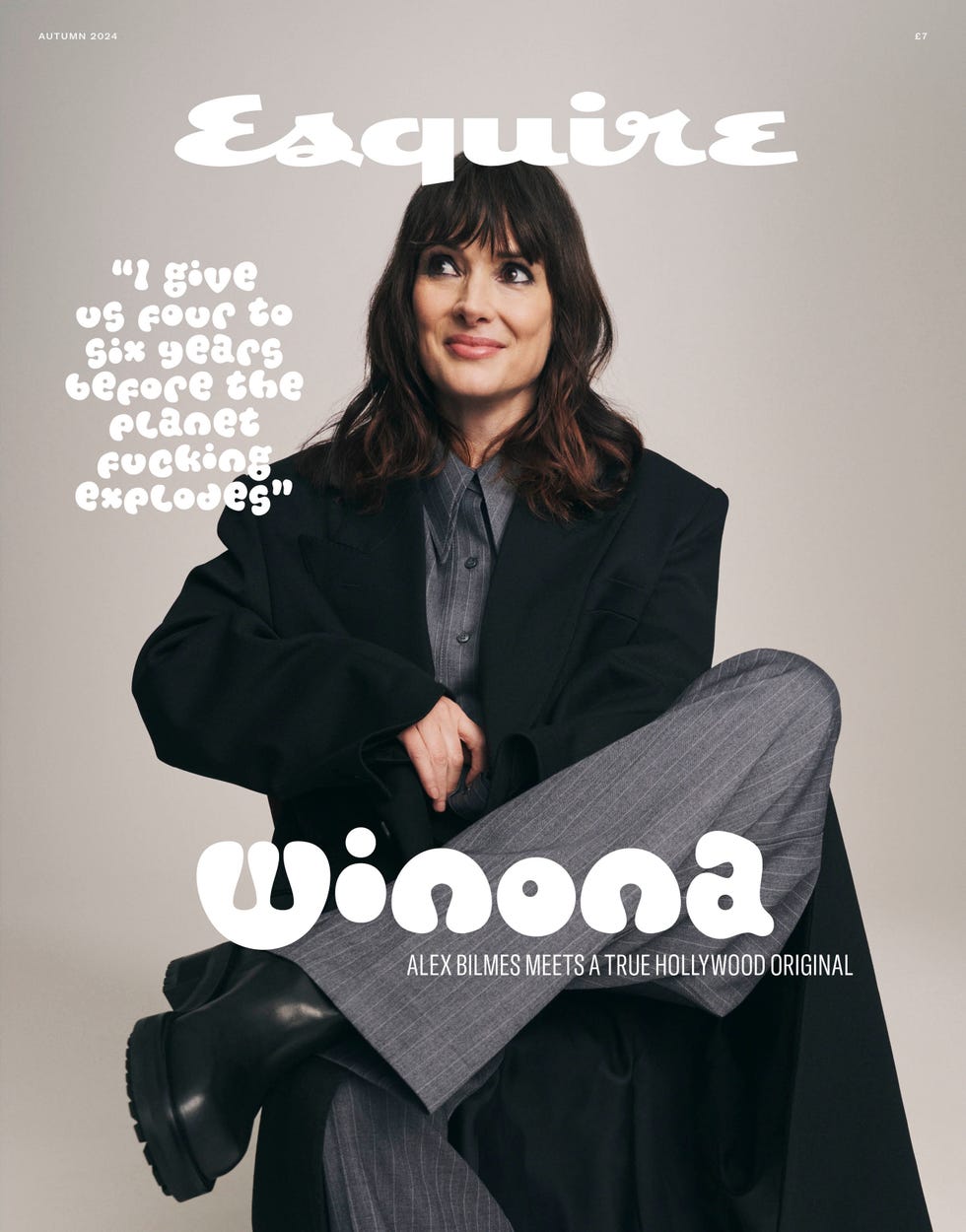
Esquire
Photographs: Simon Emmett
Styling: Sarah Gore Reeves
Hair: Ben Skervin
Make-up: Francelle Daly
Manicure: Roseann Singleton
Producer: Jeff Schroeder
Executive producer: Lacey Gray
Stylist’s assistants: Daniel Zepeda and Izzy Lenoff
Alex Bilmes has been Editor-in-Chief of Esquire since 2011. His many pieces for the magazine include profiles of Tony Blair, George Clooney, Scarlett Johansson, Paul McCartney, Idris Elba, Penelope Cruz, Giorgio Armani, Daniel Craig, David Beckham, Sean Penn, Michael Caine and Keir Starmer. He has also written widely on the arts, culture, books, sport, fashion, politics, society, food and more for publications including the Guardian, the Financial Times, and Vogue.
References
- ^ The Face (www.esquire.com)
- ^ Stranger Things (www.esquire.com)
- ^ Beetlejuice Beetlejuice (www.esquire.com)
- ^ Heathers (www.esquire.com)
- ^ Gary Oldman (www.esquire.com)
- ^ Paul Mescal (www.esquire.com)
- ^ here (www.hearstmagazines.co.uk)